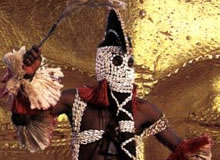Article/Document:
The Dogon Tribe
The Sphinx Group
original source | fair use notice
Summary: The Dogon people live in the Homburi Mountains near Timbuktu. At the center of their religious teachings is knowledge about a star that is invisible to the eye and so difficult to obsevrve -- even through a telescope -- that no photographs were taken of it until 1970. The Dogon say they received their knowledge by visitors to the earth from another star system.
In 1995, two French Astronomers published the results,
after years of study, and stated that a small, red-dwarf star
seems to exist in the Sirius star system...*
The Dogon people live in the Homburi Mountains near Timbuktu. At the center of their religious teachings is knowledge about a star that is invisible to the eye and so difficult to obsevrve -- even through a telescope -- that no photographs were taken of it until 1970. The Dogon say they received their knowledge by visitors to the earth from another star system.
The star they describe is Sirius B. Its existence was first suspected by Western astronomers in 1844, when irregularites were noticed in the movement of Sirius. It was supposed that Sirius must be affected by a second star, and in 1862 a faint companion star was finally detected. Sirius B is a white dwarf that, although small and faint, is extremely dense and heavy enough to exert an influence on Sirius A.
The Dogon name for Sirius B (Po Tolo) consists of the word for star (tolo) and "po," the name of the smallest seed known to them. By this name they describe the star's smallness -- it is, they say, "the smallest thing there is." They also claim that it is "the heaviest star," and white. The Dogon thus attribute to Sirius B its three principle properties as a white dwarf: small, heavy, white.
They go on to say that it has an is elliptical orbit, with Sirius A at one foci of the ellipse (as it is), that the orbital period is 50 years (the actual figure is 50.04 +/- 0.09 years), and that the star rotates on its own axis (it does). The Dogon also describe a third star in the Sirius system, called "Emme Ya" ("Sorghum Female"). In orbit around this star, they say, is a single satellite. To date, Emme Ya has not been identified by astronomers.
In addition to their knowledge of Sirius B, the Dogon mythology includes Saturn's rings, and Jupiter's four major moons. They have four calendars, for the Sun, Moon, Sirius, and Venus, and have long known that planets orbit the sun.
The Dogon say their astronomical knowledge was given to them by the Nommos, amphibious beings sent to earth from Sirius for the benefit of mankind. The name comes from a Dogon word meaning "to make one drink," and the Nommos are also called Masters of the Water, the Monitors, and the Teachers.
The Nommos were more fishlike than human, and had to live in water. They were saviors and spiritual guardians: "The Nommo divided his body among men to feed them; that is why it is also said that as the universe "had drunk of his body," the Nommo also made men drink. He gave all his life principles to human beings."
The Nommo was crucified and resurrected and in the future will again visit the earth, this time in human form. Later he will assume his amphibious form and will rule the world from the waters.
Dogon mythology is known only by a number of their priests, and is a complex system of knowledge. Such carefully guarded secrets would not be divulged to friendly strangers very easily. If the star Emme Ya is eventually discovered in the Sirius system, this would give considerably weight to the Dogon's story.
* NOTE CITE: BENEST, Daniel and Duvent, J.L. "Is Sirius a Triple Star?" ASTRONOMY AND ASTROPHYSICS. (Volume 299, 1995) pp. 621-628. -- In 1995, two French Astronomers published the results of years of study, stating that a small, red-dwarf star seems to exist in the Sirius star system. They have detected a peturbation in the orbit that cannot be explained by any other means. Article was received, October 11, 1994, and accepted for publication on November 8, 1994.
Read more articles on this topic:






